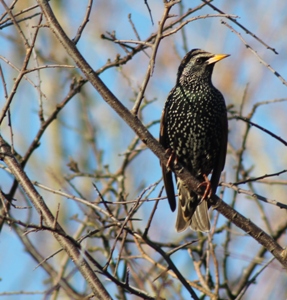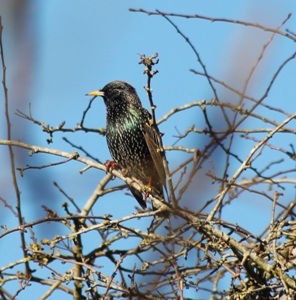Starling (Sturnus vulgaris)
It is, for example, a rare exponent among smaller birds of intraspecific brood parasitism – that is, it will lay eggs in the nests of strangers of its own species. This is a cheap way for a female to add to her productivity without having to make any more effort than laying an egg, thereby leaving it in the care of unwitting foster parents. In some colonies as many as 46% of nests have been found to contain eggs lacking any genetic material from the sitting bird or its partner. Remarkably, on its visits to a neighbour’s nest a female Starling will sometimes actually eat or destroy an egg to even up the clutch numbers, mimicking the destructive habits of the Common Cuckoo.
The nest, placed in a hole in a tree or building, was for a long time considered nothing special. But then it was discovered that, in choosing suitable material for the structure, the Starling actually uses its sense of smell as a quality control tool, presumably in order to detect material that could aid nest sanitation or have some other benefit.
The breeding cycle is unusual in that, when birds in a colony are laying their first clutch, all do so in a highly synchronised manner, with the eggs all being laid within a few busy days. When it comes to second clutches, however, the egg dates are all over the place, with little or any synchronisation – and, one would presume, this reduces opportunities for parasitism.
The young take about three weeks to fledge, and once they have done so they are determinedly independent. They leave the parents’ territory within hours and form their own special flocks, like gangs of adolescents. These flocks may number hundreds, or even thousands of birds, every one of them a juvenile; meanwhile the adults remain, as is their custom, in much smaller, quite intimate parties.
Outside the breeding season Starlings are also famed for their commuting habits and enormous roosts. Roosts form in places such as low scrubby bushes, reedbeds and buildings in town centres, and suitable sites attract birds from as much as 50km away, which fly in from all directions in the evening. The commuting flocks coalesce into vast swarms of birds, which may indulge in spectacular aerial manoeuvres prior to entering the actual roost itself. The birds are often very noisy throughout the night and, when dawn breaks, they are ready for departure to their feeding grounds. The departure is staggered, with birds leaving at intervals of about three minutes; how each bird knows which departure is allotted to it is quite unknown.
Finally, Starlings also have interesting voices and their effervescent songs often contain remarkably accurate mimicry, not just of other bird species (Golden Oriole is a favourite), but of other environmental noises. In urban areas individuals have copied crying babies, telephone rings and doorbells, among other things. Each individual male has its own personal repertoire of 20-70 song segments.


